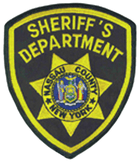Nassau County Sheriff's Department (New York)
The Nassau County Sheriff's Department is Nassau County, New York's oldest law enforcement agency. The Nassau County Sheriff's Department currently employs approximately 1200 people.
| Nassau County Sheriff's Department | |
|---|---|
 Sheriff's Department, Nassau County, New York | |
| Abbreviation | NCSD |
| Agency overview | |
| Formed | 1899 |
| Jurisdictional structure | |
| Operations jurisdiction | Nassau County, New York, USA |
 | |
| Map of Nassau County Sheriff's Department's jurisdiction. | |
| Size | 453 square miles (1,170 km2) |
| Population | 1,334,544 (2000) |
| General nature | |
| Operational structure | |
| Headquarters | East Meadow, New York |
| Correction Officers and Deputy Sheriffs | 1,000 |
| Civilians | 300 |
| Agency executive |
|
| Facilities | |
| Lockups | Nassau County Correctional Center (Correction Officers) |
| Patrol cars | Ford Explorers, P71 Police Interceptors, Inmate Transport busses and vans, Mobile Emergency Command |
| Website | |
| NCSD Website | |
The origin of the sheriff
The origin of the sheriff is traceable to the Office of the Sheriff and Constable of early English history. On Long Island, from 1664 to 1683, ridings were used to establish boundaries within the Shire. The east riding comprised the territory now occupied by Suffolk County, New York. The west riding consisted of Kings County and Newtown (Queens County, New York). The remainder of Long Island belonged to the north riding. Collectively, the three ridings were called York shire.
The governor appointed a "high sheriff" for York Shire with a deputy sheriff from each riding. In 1683, the ridings were abolished and the West riding became Nassau County. The high sheriff was no longer necessary being that each county would now have its own sheriff.
After the American Revolution, the practice of the governor appointing a sheriff continued and was incorporated into the first Constitution adopted in New York in 1777. At the Constitutional Convention in 1821, the appointed Office of the Sheriff was made elective.
On April 27, 1964, then-Nassau County Sheriff candidate Thomas M. Dugan held a press conference in Mineola calling for the position to be transformed from an elective office to that of an appointed position.
Although Dugan, a Democrat from Greenvale, was essentially campaigning on a pledge to end the $19,775-a-year position he would assume if he won the November election, his rationale was a simple and familiar one. The sheriff’s office, which manages the safety and security of inmates at county jails, transports prisoners, conducts evictions, and executes warrants, was “traditionally filled by party hacks” of the local Republican Party, who then gave jobs out to “lesser and unqualified party hacks.”
Dugan alleged that “personnel at the county jail were forced to pay one percent of their annual salary as a kick back to the Republican Party,” according to Newsday reporting during the campaign. Dugan cited Sheriff Jesse Combs, a Republican in office at the time, of having “coerced 150 GOP county workers to attend a campaign meeting and to make contributions to the party.” Dugan advocated that the Nassau County Sheriff’s position be removed from the political realm to that of an appointed position and that nearly all other jail positions personnel be filled through civil service.
He argued this would curb corruption and improve efficiency. In spite of running in a county where Republicans had 130,000 more enrolled voters than Democrats, Dugan won by 53,386 votes after a hard-fought campaign.
Just 11 days after being sworn into office, Dugan died suddenly of a heart attack. He was 37 years old.
Two months later, three Nassau Democrats introduced a bill in the state legislature proposing that the position of Nassau County Sheriff be appointed rather than elected. The measure passed both chambers.
“Tom Dugan’s Bill,” as it had come to be known, hit a roadblock when it landed on the desk of then-Gov. Nelson Rockefeller. In his veto message to the legislature in rejecting the measure, the governor stated the legislation should be handled at the county level, not the state. Rockefeller was referencing Article IX of the New York Constitution, which allows for each local government to initiate a referendum regarding removing power from elective officials.
“[A]ny … local law which … transfers to another county officer or agency any power of an elective county officer … shall be subject to a permissive referendum,” it states.
Local lawmakers in Nassau quickly took up the issue. Five days after the defeat in Albany, the Nassau Board of Supervisors — the predecessor to the Nassau County Legislature — passed a resolution in August of 1965 agreeing to put the matter before voters that November.
The local proposal was known as Proposition No. 1. It detailed that the Nassau County executive would appoint the sheriff with approval by a majority of the board. To obtain bipartisan support, it was stipulated that if Prop 1 passed, it wouldn’t take effect until 1968.
Newsday weighed in on the measure just days before voters went to the polls.
“We believe this is a worthwhile effort to streamline and update an important division of county government and we urge a ‘yes’ vote on this proposition,” the newspaper editorialized.
Had Rockefeller or Albany lawmakers or the Nassau Board of Supervisors read the state constitution beyond Article IX, which supported their objective, they would have noticed Article XIII, which didn’t. This section forbids both the legislature’s majority will and referendum action regarding a very specific officeholder: The county sheriff.
Again, article XIII reads “the sheriff … of each county shall be chosen by the electors.” If our state constitution provided a flexible option for the position to no longer be elective, as was the office in 1965, the constitution would read “the sheriff…of each county may be chosen by the electors.” (emphasis added)
Proposition 1 was approved by a landslide 294,721 to 79,685 vote in November of 1965. On Jan. 1, 1968, Joseph F. Maher was sworn in as the first appointed — and unconstitutional — sheriff in Nassau County history.
Over the past half century, Thomas Dugan’s vision to end the cycle of patronage and corruption has achieved mixed results. While civil service employees have served the correctional system well, the appointment of Nassau County Sheriff has created as much cronyism as when the position was elective. We need only look to recent headlines to see that the accountability and transparency residents deserve remains seriously wanting.
Offices
The Nassau County Sheriff’s Department is broken down into two distinct divisions known as the Correction Division and the Enforcement Division.
The mission of the Correction Division is to provide a safe and secure environment for the staff and inmates, while providing for the care, custody, and control of detainees and prisoners committed to its custody by the judiciary. In this regard, the Department is required to comply with all laws, specifically correction law, oversight agencies, specifically the New York State Commission of Correction, existing consent decrees, and Court mandates.The Correction Division is staffed by Correction Officers who are sworn Peace Officers pursuant to Article 2.10 Subsection 25 of the state Criminal Procedure Law.[1]
It is the mission of the Enforcement Division to carry out the orders of the New York State Courts including the discovery and seizure of property, the execution of warrants, and to conduct evictions. The Division also assists the Department of Social Services in the location of assets of parents who fail to support their children. The Enforcement Division is staffed by Deputy Sheriff's who are sworn Police Officers pursuant to Article 1.20 Subsection 34(B) of the states Criminal Procedure Law.[2]
- Nassau County Sheriff's Department Corrections Division -(Correction Officers)
- Logistical Support Unit (L.S.U) - (Civilian)
- Operations Unit
- Security Unit
- Sheriff's Bureau of Investigation (SBI)
- Medical Investigations Unit
- Internal Affairs Unit
- Criminal Investigation Unit
- Gang Unit
- Grievance Unit
- Communications Unit
- K-9 Unit
- Transportation Unit
- Visiting Unit
- Rehabilitation Unit
- Medical Unit
- Sheriff's Emergency Response Team (S.E.R.T)
- Nassau County Sheriff's Department Enforcement Division -(Deputy Sheriffs)
- FAMILY COURT
- S.L.A.P. (Sheriff's Location of Assets Program)
- Domestic Violence Unit
- MINEOLA OFFICE
- Landlord Tenant Unit
- Personal and Real Property Section
- Income Execution Section
- Field Unit
- FAMILY COURT
Fallen officers
Since the establishment of the Nassau County Sheriff's Department, 4 officers have died in the line of duty.[3]
| Officer | Date of Death | Details |
|---|---|---|
| Corrections Officer George H. Klimpel | Automobile accident | |
| Corrections Officer Maureen F. Callanan | Automobile accident | |
| Corrections Officer Anthony L. Brown | Gunfire | |
| Corrections Officer John R. Allen | Fall | |
See also
- List of law enforcement agencies in New York
- List of Long Island law enforcement agencies